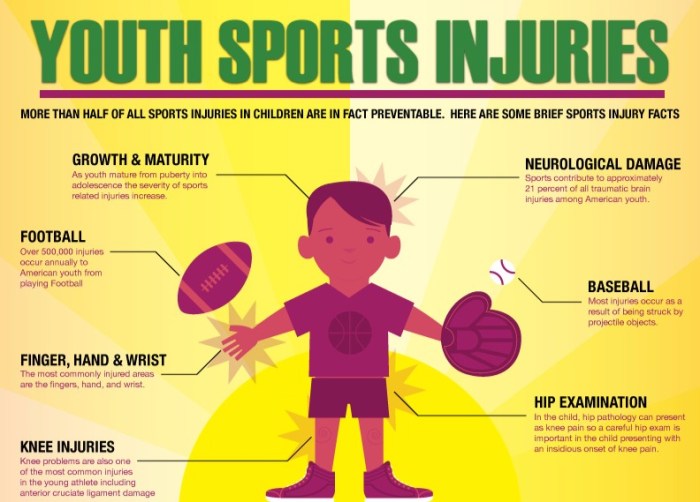Sports injury prevention is a critical aspect of every athlete’s journey, ensuring they stay in the game and perform at their best. From avoiding common injuries to using proper techniques, let’s dive into the world of injury prevention and how it shapes athletic success.
In the realm of sports, injuries can be a game-changer, affecting not just performance but also the entire career trajectory of athletes. By taking proactive steps to prevent injuries, athletes can maintain their edge and reach their full potential on the field or court.
Importance of Sports Injury Prevention

In the world of sports, injury prevention is a critical aspect that athletes must prioritize to maintain their physical well-being and performance levels. By taking proactive measures to prevent injuries, athletes can avoid setbacks that may hinder their progress and success in their respective sports.
Impact of Injuries on Athlete’s Performance and Career
Injuries can have a significant impact on an athlete’s performance and overall career trajectory. When an athlete gets injured, they may be forced to take time off from training and competition, leading to a decline in their skills and physical condition. This can ultimately affect their performance in games and competitions, jeopardizing their chances of achieving their goals and aspirations in their sports career.
Common Sports Injuries that can be Prevented
- Sprains and Strains: These are common injuries that occur when ligaments are stretched or torn due to sudden movements or overexertion. Proper warm-up exercises and stretching routines can help prevent these injuries.
- Fractures: Fractures can occur as a result of high-impact collisions or falls during sports activities. Wearing protective gear and following safety guidelines can reduce the risk of fractures.
- Tendonitis: Tendonitis is inflammation of the tendons, often caused by repetitive motions or overuse. Giving the body enough time to rest and incorporating cross-training exercises can help prevent tendonitis.
- Concussions: Concussions are a type of traumatic brain injury that can occur in contact sports. Using proper protective equipment and following concussion protocols can lower the risk of concussions.
Strategies for Sports Injury Prevention
When it comes to preventing sports injuries, there are various techniques and methods that athletes can incorporate into their training routines. From stretching to strength training and proper warm-up and cool-down routines, each plays a crucial role in minimizing the risk of injuries.
Stretching vs Strength Training
- Stretching: Regular stretching exercises help improve flexibility and range of motion, reducing the likelihood of muscle strains and tears during physical activity. It is important to perform dynamic stretches before a workout and static stretches after to enhance muscle elasticity and prevent injuries.
- Strength Training: Building muscle strength not only enhances athletic performance but also provides support to joints and ligaments, reducing the risk of overuse injuries. Incorporating resistance training into a workout regimen can help athletes maintain proper form and technique, reducing the impact on vulnerable areas of the body.
Proper Warm-up and Cool-down Routines
- Warm-up: A proper warm-up routine prepares the body for physical activity by increasing blood flow to the muscles, raising body temperature, and enhancing joint flexibility. This helps reduce the risk of muscle strains and other soft tissue injuries during exercise.
- Cool-down: Cooling down after a workout is essential for promoting muscle recovery and preventing stiffness. It allows the heart rate to gradually return to its resting state, helps remove metabolic byproducts from the muscles, and reduces the risk of post-exercise soreness.
Nutrition and Hydration for Injury Prevention
Proper nutrition and hydration play a crucial role in reducing the risk of sports injuries and promoting faster recovery.
Importance of Nutrition in Injury Prevention
A balanced diet rich in nutrients such as vitamins, minerals, and antioxidants can help prevent inflammation in the body, reducing the likelihood of injuries. Foods high in Omega-3 fatty acids, such as salmon and chia seeds, can help reduce inflammation and promote healing.
Hydration and Muscle Function, Sports injury prevention
Hydration levels directly impact muscle function and overall performance during physical activity. Dehydration can lead to muscle cramps, fatigue, and decreased coordination, increasing the risk of injuries. It is essential to drink an adequate amount of water before, during, and after exercise to maintain optimal hydration levels and prevent muscle-related injuries.
Equipment and Gear for Injury Prevention: Sports Injury Prevention

Proper sports equipment and gear play a crucial role in preventing injuries during physical activity. The right gear can provide support, protection, and stability, reducing the risk of common sports-related injuries.
Types of Footwear for Injury Prevention
- Athletic Shoes: Designed for specific sports activities, such as running, basketball, or tennis, athletic shoes provide cushioning, support, and traction to prevent foot and ankle injuries.
- Cleats: Cleats are essential for sports played on grass or turf, like soccer or football, as they offer traction and stability to prevent slips and falls.
- Specialized Shoes: Some sports require specialized footwear, such as cycling shoes with cleats, to enhance performance and reduce the risk of overuse injuries.
Use of Helmets, Pads, and Braces
Helmets, pads, and braces are crucial protective gear that can significantly reduce the risk of common sports injuries.
- Helmets: Essential for sports like cycling, skateboarding, and football, helmets protect the head and reduce the severity of head injuries in case of falls or collisions.
- Pads: Knee pads, elbow pads, and shoulder pads provide cushioning and support, reducing the impact on joints and bones during contact sports like hockey or volleyball.
- Braces: Ankle braces, knee braces, and wrist braces offer stability and prevent excessive movements that could lead to sprains or strains during sports activities.